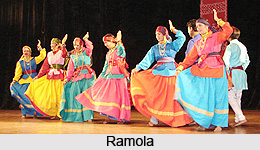 Ramola is a famous folk dance form performed in the Uttarakhand state of India. This dance is a charming heritage of Bard community of this state. The community roams from one place to another. The dance is performed by bard tribe with onset of spring season. The new season is welcomed by birds that roam from place to place and is celebrated with joy and happiness.
Ramola is a famous folk dance form performed in the Uttarakhand state of India. This dance is a charming heritage of Bard community of this state. The community roams from one place to another. The dance is performed by bard tribe with onset of spring season. The new season is welcomed by birds that roam from place to place and is celebrated with joy and happiness.
Mythological Story of Ramola
The popular story that revolves behind the Ramola dance has a lot of mythological significance. One day Sidha, while resting under a tree of rhododendron, played his flute. Impressed and fascinated by the quality of the music, the fairies from the court of Indra, descended on earth and carried away his soul to the heaven. In the mean time, sister of Lord Krishna, Brinjamati, had a dream, and she went looking for her husband. Her worst reality came true and she found the dead body of her husband. Hit by sadness and grief she went to Dwarka, her brother, who was well aware of what had happened and promised to assist her.
Krishna went back to the banks of Mansarovar and played his flute with extremely dedication and passion. Enchanted and thrilled by the sound of the flute, fairies forgot to keep an eye on their clothes. Taking this opportunity, Krishna whisked them all away and climbed atop the tallest tree on the shore. He continued to play his flute. The fairies requested Lord Krishna to give them back their clothes, but Krishna did not pay any heed to them and continued to play. He refused to give them back their clothes till they promised to free Sidha and give him back, alive to his wife. The fairies got their clothes and Krishna`s sister got her husband.
Performance of Ramola
During the festival of Holi, people of this place come together forgetting their worries. The festival lasts for more than a month and hundreds of songs of classical, semi classical, and folk variety are sung by the performers. Ramola is performed by both men and women. The dancers dress themselves in colourful costumes and wear traditional jewelleries.
Instruments of Ramola
Musical instruments like harmonium, tabla, dholak and manzira (cymbals) accompany this traditional dance.



















